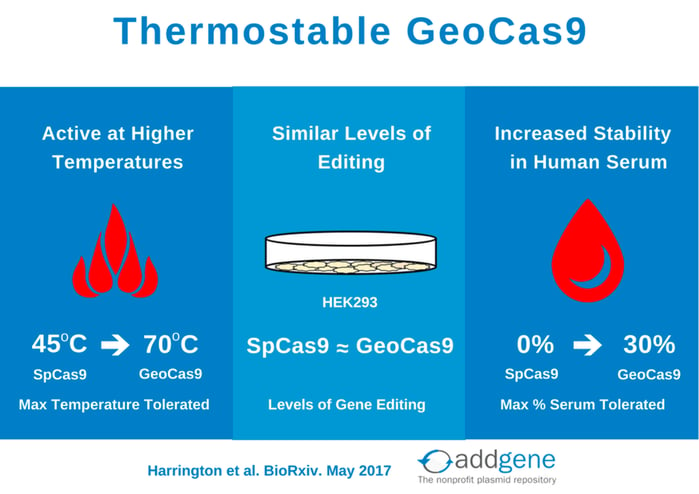
Cas9 is the genome editing tool of choice for a number of model organisms: mammalian cells, yeast, drosophila, plants, worms, zebrafish, frogs, some bacteria; but not thermophilic (high heat loving) bacteria. Until recently the only available Cas9 proteins were isolated from mesophilic (medium heat loving) bacteria, such as Streptococcus pyogene’s SpCas9. These Cas9 proteins don’t work well at high temperatures, so to use them in thermophiles, bacteria must be grown at lower temps. This approach only works for facultative thermophiles (high OR medium heat loving), but not obligate thermophiles. However, the recent discovery of GeoCas9 by the Doudna lab has opened up the field of thermophilic bacteria to CRISPR/Cas9 genome editing.
How was GeoCas9 discovered?
The discovery of GeoCas9 started with an interesting question: why engineer a new Cas9 when you can just find one that naturally occurs? This is different than the engineered approach used to make eSpCas9 and SpCas9-HF1. By mining the treasure trove of naturally occurring Cas9 diversity via the Integral Microbial Genomes (IMG) database, Harrington et al discovered a Cas9 protein from the thermophilic bacteria Geobacillus stearothermophilus (GeoCas9). G. stearothermophilus grows at temperatures ranging from 30-74 °C, with an optimal growth temperature of 55 °C. For a brief comparison of GeoCas9 vs. SpCas9, see the table below and read on to learn more about GeoCas9.
| SpCas9 | GeoCas9 | |
| Size | 1368 AA |
1087 AA |
|
PAM Sequence |
NGG |
CRAA (R = A or G) |
| Spacer Length | 20 nt | 22 nt |
| Temperature Range for Optimal Activity | 35 - 45 °C | 50 - 70 °C |
| Genome Editing in Mammalian Cells? | Yes | Yes |
| Longevity in Serum?* | No | Yes |
Table 1. Comparing SpCas9 and GeoCas9. *For in vitro Cas9 RNP activity or longevity.
GeoCas9 is active at high temperatures
 |
| Figure 1: Thermostability of SpCas9 vs GeoCas9. SpCas9 or GeoCas9 RNPs were incubated in reaction buffer at temperatures ranging from 25-80 °C. Activity is expressed as Kcleave (min-1). SpCas9 has maximum activity from 35-45 °C, while GeoCas9 has maximum activity from 50-70 °C. |
The key advantage of GeoCas9 is that it functions at temperatures much warmer than SpCas9 can tolerate. Harrington et al tested GeoCas9’s love of heat in two ways. The first set of experiments tested the ability of GeoCas9 RNPs to be incubated at high temps but still maintain activity following heat treatment. The second set of experiments tested the ability of GeoCas9 RNPs to cleave substrate when the reaction was carried out at elevated temperatures. In both cases, GeoCas9 outperformed SpCas9 at high temperatures. See Figure 1 for a summary of the experimental results.
GeoCas9 RNP editing in mammalian cells
Besides being able to take some heat, GeoCas9 can introduce genomic edits in mammalian cells. Harrington et al tested GeoCas9’s editing skills by transfecting HEK293 cells with GeoCas9 or SpCas9 RNP’s and a guide targeting a site with an overlapping PAM. In both cases, GeoCas9 and SpyCas had similar levels of editing. See figure 4 in Harrington et al for more examples of GeoCas9’s editing activity in HEK293’s.
GeoCas9 stability in human plasma
The last trick GeoCas9 has up its sleeve is its increased longevity in human serum. Harrington et al suspected GeoCas9 might have higher stability since prior research had shown that a cocaine esterase engineered to have increased thermostability also had a longer lifetime in human blood. To test if this was also true for GeoCas9, Harrington et al incubated SpCas9 and GeoCas9 RNPs in diluted human plasma for 8 hours at 37°C. Substrate was then added and enzyme activity measured. SpCas9 was inhibited by 10% plasma, but GeoCas9 remained active in up to 30% plasma.
 |
| Figure 2: Human plasma longevity of SpCas9 vs GeoCas9. SpCas9 or GeoCas9 RNPs were incubated in human plasma diluted with reaction buffer for 8 hours at either 37 °C or 4 °C. Substrate was then added and cleavage product analyzed on a gel. SpCas9 is stable when incubated in reaction buffer alone, but has limited activity when incubated in diluted human plasma. GeoCas9 remains active after being incubated in up to 30% human plasma. |
The discovery of GeoCas9 clears the way for CRISPR/Cas9 genome editing in facultative and obligate thermophiles without the need to grow the organisms at lower than optimal temperatures. GeoCas9’s thermostability could also be used with in vitro molecular bio applications that require high temperature reaction conditions. Finally, its longevity in human serum may allow for more efficient genome editing via RNPs in vivo.
What aspect of GeoCas9 are you most excited about? Thermostability? Longevity in human plasma? Something we haven’t thought of yet? Let us know in the comments below. And if you want to give GeoCas9 a try, as always, the plasmids are available from Addgene. Happy CRISPRing!
References
Harrington, Lucas, et al. "A thermostable Cas9 with increased lifetime in human plasma." bioRxiv (2017): 138867.
Additional Resources on the Addgene Blog
- Read about CRISPR Methods for Bacterial Genome Engineering
- Interested in using CRISPR/Cas9 RNPs? Check out this post
- Check Out Other Blog Posts on CRISPR
Additional Resources on Addgene.org
- Brush Up on Your CRISPR Background with Addgene’s CRISPR Guide Page
- Find CRISPR plasmids at Addgene
Topics: CRISPR, Cas Proteins






Leave a Comment